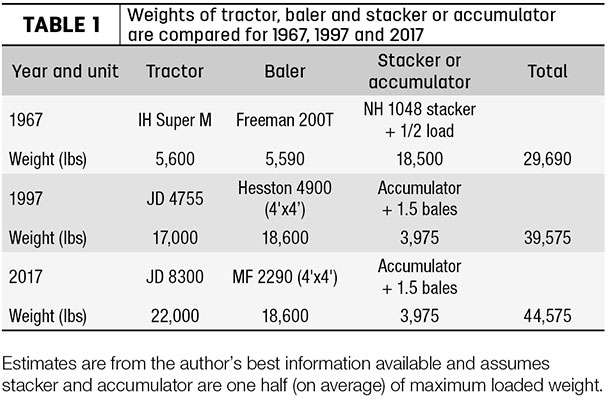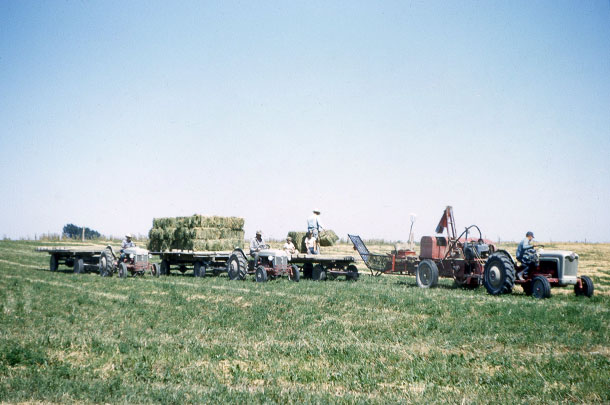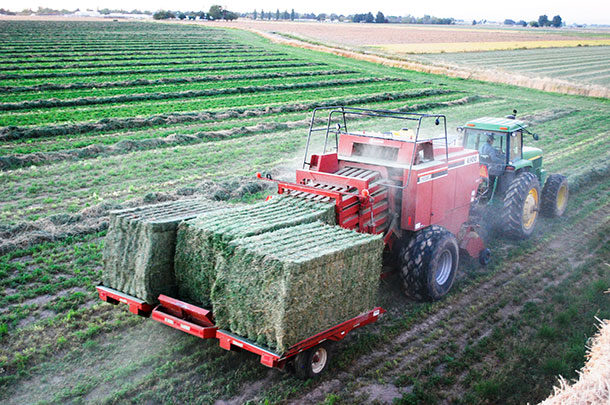However, I wonder if we have crossed over the threshold of efficiency and are producing more long-term damage to soil structure, water holding capacity, nutrient availability, the potential for root exploration of the soil and significant plant damage to new buds in alfalfa and forage crops. Are we in a soil death spiral from making bricks out of our soil from compaction, and then using expensive deep tillage equipment to break up the bricks?
Soil compaction should be a concern to all producers, whether you have your own “big iron” or hire it done with bigger iron. However, the solution from a crop production standpoint is not necessarily duals front and back. The fact is that duals will double the crushing of new buds from alfalfa and grasses. Research has shown a 15 percent reduction in yield for the next cutting because of wheel traffic.
Farmers must love duals, or they hate to take them off! Duals will reduce surface compaction on the single wheel track; however, duals increase total compaction from the added weight and spread that compaction over twice the area. Paul Jasa, University of Nebraska Extension engineer, recommends producers should run wide singles and simply add weight to increase the pull if needed, especially with front-wheel assist tractors. Jasa also recommends that duals should also be on the front if you have them on the back for optimum traction with front-wheel assist. However, turning with duals mounted on the front does a lot of damage to buds. Driving circular on a pivot would be the solution for that situation.
Do we really need a 140-horsepower, fully weighted tractor to pull a rake? I am perplexed by the amount of front weights left on the baler and rake tractors. This really points to the “big iron” syndrome. I think there are few situations where you need that weight for traction. You want minimum wheel slippage because that destroys buds and compacts soil worse than proper weight-to-tread print. Some producers who pull a steamer and large baler on hills tell me it’s necessary, but I see a lot of excess weight on 1 percent slopes.
By how much weight has equipment increased in the last 50 years, from 1967 to 2017? I was baling with an IH Super M and Freeman 200T, a two-string baler with an air-cooled Wisconsin engine, in 1967. (By the way, that was an upgrade from 1957 when my cousins were driving a Ford 8N with a New Holland “horse head” baler.) Now our farm is using a John Deere 4755 and a Hesston 4900 with an accumulator. No, we have never had the newest equipment, except when my brother and I went to college and Dad bought a New Holland 1048 stacker that my little brother ran. Let’s add up and compare the weights in Table 1.

Total weight per pass in 1967 was 75 percent of 1997, and 67 percent of 2017. However, it is common to rake two windrows into one for large balers, which reduces baler and stacker passes by half. Tire sizes are taller and narrower for the newer tractors, but the weight is substantially more in the tracks.
Good things about new designs
Ideally we would have equipment with all wheels in line. If the mower, rake or accumulator, and baler would all track in the same tracks, it would minimize bud damage to perennial forage crops. The use of GPS makes this achievable if equipment designers would cooperate. The newer large rectangular balers with smaller tandem wheels that can be aligned with tractor wheels are an improvement over the wide tires on older large balers. The accumulator wheels, however, are set out farther and run over more buds.
(By the way, English and math teachers should be dismayed by the common term of “square baler.” Many non-round balers have a rectangular cross section such as 4X3. The only “square balers” have a square cross section such as a 4X4 or 3X3.)

Reduce “big iron” yield loss
To reduce yield losses caused by wheel traffic and compaction:
- Plant alfalfa varieties that are selected for traffic tolerance.
- Don’t harvest on wet soil or frozen plants.
- Harvest as quickly as possible after cutting.
- Rake within two days of cutting and merge swaths into windrows that match your baler.
- Use front-wheel assist, if necessary, to reduce slippage.
- Avoid dual wheels and unnecessary weights, but avoid slippage.
- Use the lightest equipment (especially tractors) needed to complete the job.
- Adjust equipment so wheels trail one another.
- Minimize trips across the field.
- Use an accumulator to collect and drop bales in groups.
- Drive stacking equipment and trucks on the same path and remove bales as soon as possible.
No, I don’t expect anyone to drag out the old equipment, but producers and equipment manufacturers should consider the impact of their management on future forage harvests and do what they can to minimize compaction and bud damage. ![]()

-
Glenn Shewmaker
- Forage Extension Specialist
- University of Idaho
- Email Glenn Shewmaker
PHOTO 1: In today’s world of heavier ag equipment, alfalfa buds can be injured and compaction can result unless producers take steps to minimize damage. Photo by Glenn Shewmaker.
PHOTO 2: Our equipment was never "new," but this haying photo, taken circa 1957, shows a Ford 8N with a New Holland “horse head” baler was used to bale hay. Photo provided by Glenn Shewmaker.










